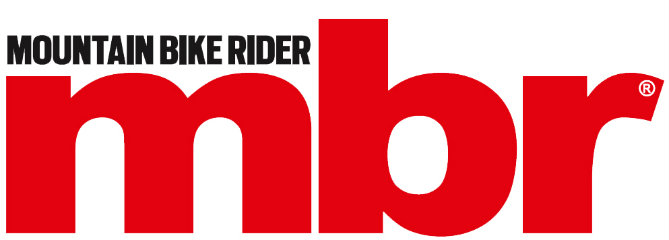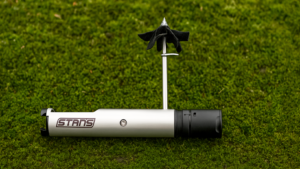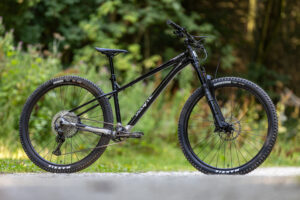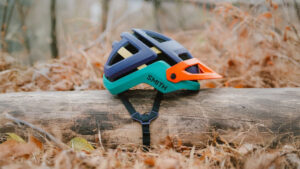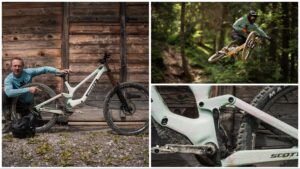The Yeti SB140 comes in this UK-only Silverfish special edition, and with supple suspension punching well above its weight and brilliant pedalling performance, I really think it's The One.
After 20 years testing, Yeti’s SB140 Silverfish is the one bike I’d actually buy… and with cheaper models in the range you don’t HAVE to spend £9,000
Colorado-based Yeti is one of the true OG American bike brands, having been around since George Michael and Wham were Careless Whispering in 1985. It’s not overstating anything to say it’s created some of the classic designs and innovations that have helped define modern mountain biking, and also somehow successfully made the colour turquoise entirely its own in the MTB world.

Yeti as 40 years of history behind it, and they’ve learnt how to make a supple frame in that time
In recent years, distinctive Switch Infinity bikes with the SB prefix have been the brand’s go-to design across multiple travel brackets, with this latest SB140 sitting in the middle of its range and aimed squarely at trail riding.
– Short of time? Click here to skip to the verdict –
Alongside the famous turquoise, Yeti’s 140mm rear travel rig also comes in black and this gorgeous sparkly racing green. All colours share a unique silhouette thanks to a pair of little gold Kashima-coated shafts above the bottom bracket, which, judging by how many times people asked me on the trail, look like a tiny pair of suspension forks or miniature dampers.

Not dinky little Kashima coated forks, this slider is integral to Yeti’s suspension magic
The encased sliders are in fact essential components of Yeti’s unique SB suspension design that shifts how the bike pivots and behaves as it moves through the travel.
I’ve tested multiple SBs, including most recently the SB165 I raved about last summer, and also this SB140, albeit in a slightly different guise. I’ll fess up and admit that when I reviewed Yeti’s trail bike before, I’m not entirely sure why I wasn’t as blown away as I was with the performance of the full 29er with 160mm forks here.

The SB140 is at home on flowing singletrack like this, but also on rocky, gnarly janky trails too
Maybe I’d recently crashed and taken a bang to the head or something? Whatever held me back from rating the SB140 as an absolute favourite left the chat quicker than a phone battery dying this time out. I can’t stop telling anyone and everyone that will listen how it’s one of the best mountain bikes you can buy in 2025. You’d certainly expect Yeti’s machine to delivers too, as – shock horror – it costs a pretty penny (especially in this Turq version using the brand’s best carbon).
There are plenty high-end parts on board, and the whole frame is obviously full fibre, but some might still suspect an element of Yeti’s status comes built into the high cost as well. Or, in other words, you’re paying extra for the name. I’ll try and explain why I’m not entirely sure this is the case though, there’s a good reason Yeti has maintained its cachet and boutique reputation as one of the most desirable in mountain biking for decades for nothing. And that reason is, ride feel, build quality and attention to detail. All are exceptionally high on the SB140, so maybe it’s high performance that built Yeti’s standing in the first place.

If Carlsberg made trail bikes they would probably look something like this
Design and specifications
In terms of travel, 140mm is pretty much the established benchmark for trail bikes. Not all 140mm bikes feel the same though, and Yeti’s SB140 definitely resides at the deeper-feeling end of the travel bracket. I’ll get into the details of the proprietary suspension design and what it aims to achieve in a bit, but want to first give a big shout out to how frame quality and the supple feel of Yeti’s chassis adds to the sensation of smoothness and tracking.
Turq uses a different construction to Yeti’s basic carbon, much like Santa Cruz does with its premium CC carbon, which we’ve recently been riding on the Santa Cruz Bullit AXS RSV 2025 e-bike. Yeti says it uses premium carbon for the optimum balance of stiffness, weight saving and compliance, but doesn’t really go into too many details. You can expect finer, lighter and more expensive fibres in the T-series lay-up, and also less resin or fillers and more actual carbon. Turq not only saves precious grams over less expensive C-series frames, it also rides better with a tauter, subtly springier chassis feel.

Yeti’s dodged the headset routing trap and instead designed big cable ports in the downtube
Yeti’s frames don’t offer much in the way of adjustability or packed lunch boxes, like Santa Cruz does with the Bronson, but this means they also come in pretty light, even with the complex Switch Infinity set up. It’s under 3.4kg for a Medium SB140 Turq frame with Fox Factory Float shock, while the cheaper C-series frame is 174g heavier).
On the latest model, plenty of revisions include a shorter seat tube to fit longer-stroke droppers and the slightly bulbous lump ahead of the (now threaded) BB toned down so it looks better and offers 34mm more rock impact clearance. This new shaping also comes protected by a fresh dual-density frame guard.
Each SB140 size is laid up specifically so flex and torsional stiffness are consistent, and continuing the theme of specific tailoring, chainstays grow and actual seat angle increases in increments too, so balance and climbing position remains dialled all the way from 430mm reach on Small to 525mm reach on XXL.

Despite the complexity of the suspension design, the SB140 back end actually looks pretty clean
Yeti’s geometry isn’t radical at all, with a 65° head angle that’s actually steeper than may equivalent bikes, and chainstays that are slightly longer than most too (440mm in size Large). The frame feels very roomy in the cockpit and also a bit lower in terms of stack, partly because of a stubby headtube (100mm) that needed quite a lot of spacers under the stem to get a preferred bar height.
Even with the complexity of Switch Infinity, the one-piece rear triangled frame looks very clean with it’s neat shock links and smooth lines, and it’s also very low slung and well out of the way while riding. The carbon everywhere rig is completely silent too with thick, rubberised, chainslap protection that extends all around the stays, and a tunnelled cable routing with tensioning plates on the side of the frame behind the headtube.

Switch Infinity is more than just a great piece of branding, it really does work to deliver supple, yet supportive suspension
Suspension
Switch Infinity has its origins in Yeti’s 303-R downhill bike that used a downtube rail along which the lower eyelet of the shock slid up and down. The system changed the way the suspension behaved as it moved through the travel and worked well, but had issues with crud getting in the rail/slider that affected performance and durability. It was later refined and reconfigured into an eccentric pivot where the main suspension pivot circles around off-axis.
This eccentric design graced a few successful different Yetis in the Jared Graves 26/27.5in-wheeled era, and inclided bikes like the SB66. Eventually the design morphed into the double Kashima-coated rails we see today. The latest setup is described as a 4-bar, but rather than a virtual pivot point that moves in an arc, the main pivot point here is housed in an aluminium carrier that slides up and down the rails and switches direction along a linear axis. I kind of picture it in my head as a single pivot with a moving pivot point, if that makes sense?

The ‘switch’ lets a link slide up and down two Kashima coated shafts, changing the pivot point throughout
The idea is to accurately control leverage on the shock and anti-squat curves in two different phases of travel. Switch Infinity tweaks suspension behaviour with the bike at sag, and again later, once the suspension passes a certain amount of travel – at this inflection point the pivot changes direction. The brand says the design decouples chain forces (chain growth) effectively so rider weight doesn’t inhibit the suspension as much. It also says anti-squat also drops off dramatically, from a very supportive pedal platform to more free-flowing movement for the back wheel on bigger hits deeper in the stroke.
The overall leverage ratio is relatively linear with only 14% progression and, starting under 2.75 to 1, is also pretty low leverage overall, compared to many equivalents. The SB140 does have a steeper progression curve right at the end of the stroke for extra bottom out resistance though.

Older gen Switch Infinity suffered from undue wear, but I’ve had no issues with the current Switch Infinity
Earlier Switch Infinity bikes suffered from some the same issues of crud ingress as the 303-R, and a fairly common complaint amongst Yeti owners of wear/bagginess and even Kashima coatings wearing out on the SI sliders. This latest generation has numerous improvements for better longevity. From what I’ve seen, while you still need to keep an eye on greasing the ports on the Switch rails from time to time (a cinch), the design is now way more durable.
A big part of the fix comes from new bushings and oversized bearings on the pivot carrier and also tougher and stiffer pieces elsewhere. The main pivot bearing races are linked radially and axially and a floating collet axle tightens the whole thing together directly onto the bearings. Yeti say the result is a smoother moving system that gives better suspension sensitivity as well as longer bearing life.

There’s a new upper link that makes the SB140 stiffer, and probably helps avoid wearing out the Switch Infinity link
The new upper rocker link is stiffer too, and doesn’t flex or deflect under side loads as easily, which means the shock gets driven more cleanly for smoother suspension. It also presumably translates to the main ‘switching’ pivot being subjected to less side loading or waggling by the one piece carbon rear triangle.
I’ll get more into the actual performance of the design later, but it’s worth saying here the SB140’s exemplary pedalling and sprinting performance isn’t something I’d normally associate with such a plush and beautifully smooth suspension feel.

Gold 36s look amazing, but without the Grip X2 damper they’re a harsher ride
Components
This SB140 is a bit of a one-off build for UK distributor Silverfish based around the T-Series T3 Lunch Ride (LR). LR editions pump up front travel to 160mm and add powerful brakes for a more capable ride compared to standard 150mm forked versions, and this one also has anniversary-edition Factory Float 36s in fancy Kashima gold.

I found the Grip X over damped, something we’ve found on plenty of bikes with this era fork
The 36 uses a 3-way adjustable GRIP X damper, rather than Fox’s new generation of Grip dampers boasting more support without the harshness – in this case the 4-way GRIP X2. This is a real downgrade, because while it works well, there’s not quite the same freedom of movement. There’s definitely not the same ability to drill into my exact set up as X2 either, and it can also feel slightly over-damped. There’s an annoying wheeze on the rebound too, which is admittedly much quieter here than on other forks I’ve had.
The rear Fox Factory Float X shock works great. There’s enough to mess about with to tune setup with low-speed compression, rebound adjuster and ability to add volume spacers, and it’s easy to get to a sweet spot of performance without being over complicated.

The SB140 would be much improved with tyres from Maxxis
Because Silverfish distributes them, Michelin Wild Enduro tyres replace standard Maxxis rubber. I’m not the biggest fan of this older tread pattern or the Competition Line rubber (the newer Michelin Wild Enduro MS Racing Line tyres are good), and I’d rather get a Maxxis combo. I don’t reckon you’re missing out much in this department compared with the stock build then. Wheels here are alloy Race Face Turbines with huge bulbous hubs that perform well, but aren’t the lightest or the blingiest. These are swapped out on standard T-series bikes by DT Swiss XM1700.

Maven brakes are more than powerful enough for a trail bike
Silverfish’s bike is slowed down by SRAM Maven brakes that are definitely an upgrade and some of the most powerful around. So powerful, I was glad of the smaller 180mm rear rotor that made it harder to lock the rear wheel. I would have happily taken a 180mm rotor up front too, instead of the 200mm. SRAM also does drivetrain duties, with a full XO set up with aluminium cranks. The frame has a UDH dropout to accommodate the latest T-Type mech.
Fox’s Kashima-coated Transfer dropper matches the SB140 perfectly, but like many other Fox posts, it was occasionally sticky and grouchy and doesn’t seem to work as seamlessly as something like a Bike Yoke or OneUp. A Race Face Era carbon bar I’ve already reviewed with extra built in compliance offers a more damped ride feel up front and comes clamped by a 50mm Race Face stem that I swapped out for a 35mm. This was to shorten the cockpit and also tone down the slightly too reactive (for me) steering response, which then felt bang on with the shorter stem.

Boosting out of corners is something you’re going to do a lot of, aboard this whippet of a bike
Performance
Did I mention already I absolutely loved riding this bike? It’s one of a rare handful on review that you never want to give back and had me out doing more miles than any other trail bike for a long while, purely for fun. I’d even go so far as to say that, like the SB165mm I had last year, it’s the bike in the category I’d actually buy if I was in the market and had the cash.
Climbing
Why it’s so good then? Firstly, it pedals better uphill even than my normal go-to trail bike, Santa Cruz’s Tallboy CC X01 AXS RSV. And despite having 20mm more travel, I didn’t ever have to lock out the shock unless for a prolonged slog or steep climb on tarmac – I routinely lock out the shock on the Tallboy when I’m climbing for extended periods, on or off road.
The Yeti has that sense of real drive and zest if you crank it hard too, so I felt like I could really sprint along without wasting excess energy.
Its supple too though, which means I have tons of traction and climbing bite. The Yeti boots into touch any knobbly edges and scoffs at awkward stony sections on steep technical climb puzzles. The seated climbing position is sorted too (I did inch the saddle forward a smidge) with no sense of ever tipping off the back or being so far forward pedalling it feels awkward or less efficient on more flowing trails and longer rides.

Sending the bike is part and parcel of riding the SB140, it’s just so easy to get airborne
Descending
The flip side to this is also having a very deep feel to the suspension for the advertised numbers, so it’s active and lively off-the-top and can swallow big impacts smoothly, which I’d usually associate with a less effective pedaller.
This is therefore a bike that can kill two birds with one stone, all without ever bottoming out harshly even when really sending it off bigger drops or jumps. And with the speed the Yeti rolls along trails at, believe me, I sent it deep and long often.

It’s not all about jumps though, the SB140 also sticks to the ground when you want it to
A major stand out for me is how the Yeti excels at maintaining pace. Small edges and little stones don’t chip away in the same way as on most other bikes, so it absolutely flies down the trails at speeds I’m grateful those massive Maven brakes can reel in anytime gradient is over 10%. The bike trucks on and on and you can directly measure it against mates who commented multiple times I was rolling away from them, particularly on stone-flecked, mellower, gradients.
The back end is excellent in how it gets out of the way of bigger obstacles too, and the whole ride feels beautifully floaty with so much grip around sag or under braking. Forget about it not being tight enough to rip on either; the magic sauce on the flipside (literally in the case of Switch Infinity) is tons of support at the end of the stroke to pump and push against deeper in the travel. I can lift the front or both wheels really easily up and over obstacles by pushing into the suspension. At the extreme end of this sensation, I could bounce out of bucket turns or boost off dips and lips if I really dug heels into the back end.

I’m faster on the SB140 than I’ve been in years, and that’s priceless
Yeti’s steering is precise without being nervy, and while the BB never feels too high, the riding position is very slightly head further forward and attacking than hanging off the back like some trail bikes. I reckon this makes it a superior all-rounder though and never felt I wasn’t in a balanced position to drive through feet from. I rarely use Strava these days and know it’s never 100% accurate, but the SB140 had me repeatedly recording the fastest times I’d had in years. I even collecting a couple of KOMs on trail bike/enduro tracks I ride week in, week out. Maybe it’s a coincidence, but it says something about how fast the bike is and how fast I was prepared to ride it. Maybe those gold forks and the glittery paint job really do make me go faster after all.

With more conservative geo that some of its peers, I’m still blown away by how fast I can ride it
Pretty much the only caveat I can think of is the Yeti might not be the dream bike for you if you’re a bruiser that craves a super stiff and rock-solid chassis, or you love to hang off the back and manual all the time. But it’s still more than capable of sliding the rear end about all over the place and scandi-flicking about if you’re skilful enough.
Verdict
There’s no getting around the fact that Yeti’s SB140 is a serious investment. If Carlsberg made trail bikes though, this might well be it. All that cash gets you the best riding trail bike I’ve ridden, with performance arguably a notch higher than most of its direct competitors. Yeti’s bike simultaneously blends slinkiness with support, and it still gives me that same shorter travel sense of urgency and seat of the pants feel I get from downcountry bikes. Of course it's in a different category of DH capability, bump swallowing and braking control to short travel rippers. The SB140 can also gobble up serous terrain and steeps without feeling heavy or unwieldy and maintaining 90% of the downcountry pop and zest, despite at least 20mm more travel at each end. It also looks amazing, leaving me with not many logical reasons not to recommend it, except needing a spare nine grand or so kicking about to buy into this ultimate level of performance.

